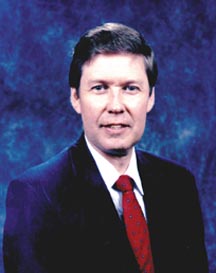by John Houghton

John Houghton is a consultant
to the Life Sciences initiative for the
state of Missouri. He can be reached
at 636.225.4672 or by email at: jmhatec@worldnet.att.net.
The states of Missouri and Kansas have made significant strides in positioning the region for economic growth in the life sciences. In Kansas, much of the interest and its development has been driven by the University of Kansas, KU Medical Center and the state of Kansas. Most of Kansas' emphasis to the life sciences is focused in the greater Kansas City area including Lawrence, KS. Missouri is certainly stepping into the life sciences as well. Since designating life sciences in 1999 as a lead industry for economic development, we've been pursuing a multi-faceted initiative aimed at growing this industry, and ensuring that all regions of the state share in this growth. MU, UMKC and universities across the state have joined the Missouri Department of Economic Development, companies and organizations in this field to position Missouri to capitalize on opportunities associated with the development of the life sciences in the region.
We set out first to determine the scope of Missouri's life sciences industry. What we discovered was exciting indeed. We identified some 225 companies, ranging from agriculture biotechnology to protein and enzyme manufacturing, and nearly 200 other entities, including universities, research institutions, and civic organizations, that comprise a substantial industry base. As expected, the majority of these were located in Missouri's largest metropolitan areas, but a surprising number were clustered in other parts of the state, including Columbia, Rolla, Springfield, and Cape Girardeau.
Even more exciting was the affirmation of a vibrant technology corridor stretching across Missouri from St. Louis to Kansas City. This corridor logically continues west to nearby Lawrence, Kansas. Fueled by world class research institutions, nationally-ranked teaching hospitals, and corporate powerhouses in biotech R&D, this corridor already displayed an ability to create the kinds of high-tech jobs that attract highly educated young professionals. It is a potential wealth generator for the region far into the future.
Already the technology corridor has been the beneficiary of significant private research funding, Kansas City's Stowers Institute and St. Louis's Donald Danforth Plant Science Center being two prime examples. The University of Missouri and Washington University, among others, regularly attract substantial federal funding for their research programs.
Our next challenge is to build a sustainable pool of investment capital to support commercial development. A menu of funding alternatives is essential to serve the varying requirements of life sciences entrepreneurs, including seed and pre-seed funds, venture capital for startups and break-out companies, and tax incentives for companies with growing revenues and expansion needs.
If we're successful in creating a business climate in Missouri that encourages the formation of life sciences startups while also meeting the needs of existing companies in the industry, we will have come a long way toward generating the competitive muscle that attracts attention from outside the region.
An added advantage is that our life sciences clusters are developing expertise across the full spectrum of the industry. Kansas City, Columbia and St. Louis focus strongly on human health research. St. Louis is also a world leader in plant research. Rolla and Springfield are building expertise in environmental studies and advanced bio-materials. Cape Girardeau is focusing on applied research and agricultural life sciences. Each cluster has unique strengths and resources, while together they generate an energy and dynamism that drives the industry statewide.
It is said that the 19th Century was the Age of Chemistry, the 20th century was the Age of Physics, and the 21st century will be the Age of Biology. Like the Kansas side of the greater Kansas City area, Missouri has a promising array of life sciences companies, located in synergistic clusters, that with careful nurturing can be a powerful engine for economic growth far into the future.
Life sciences is one of the great growth industries of our time, and Missourians and Kansans alike are fortunate to have an opportunity to share in both the achievement and the wealth this industry is destined to create.